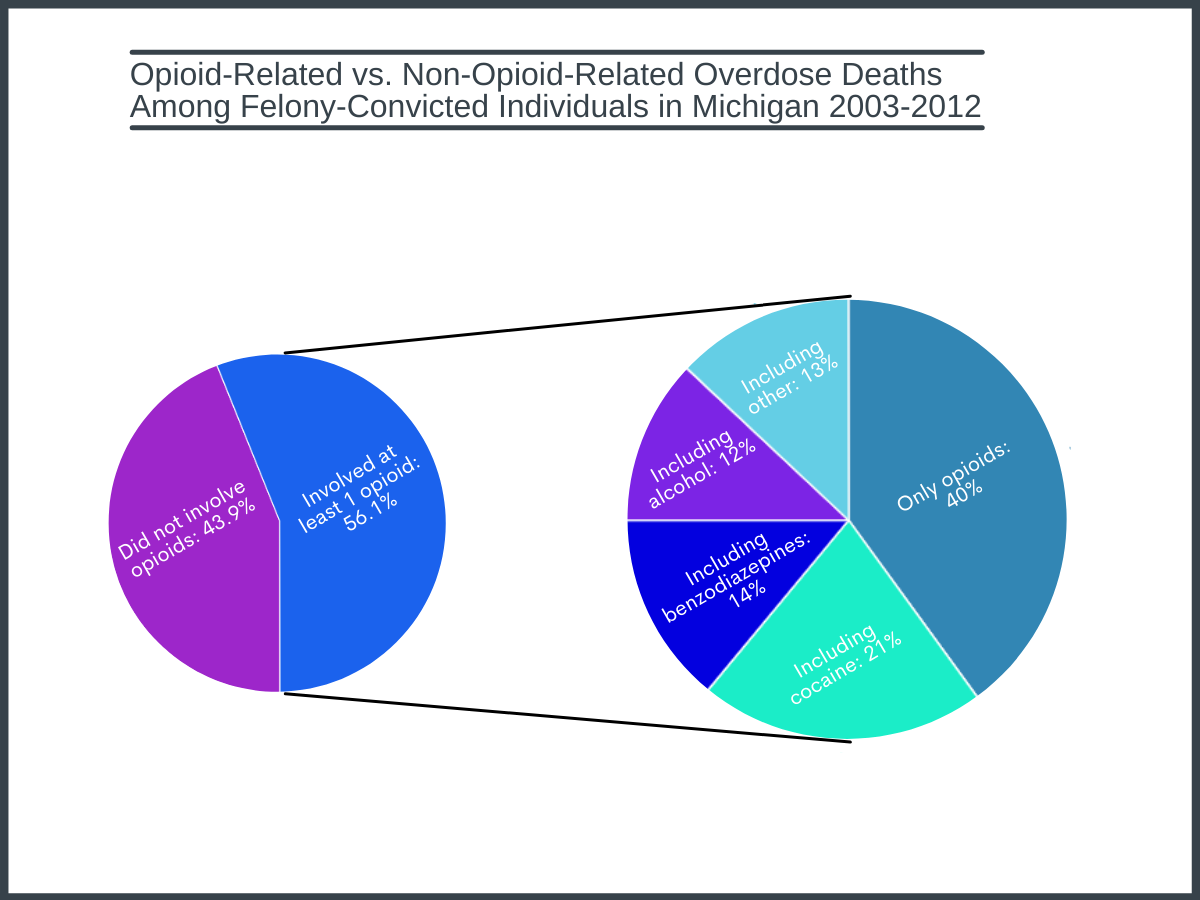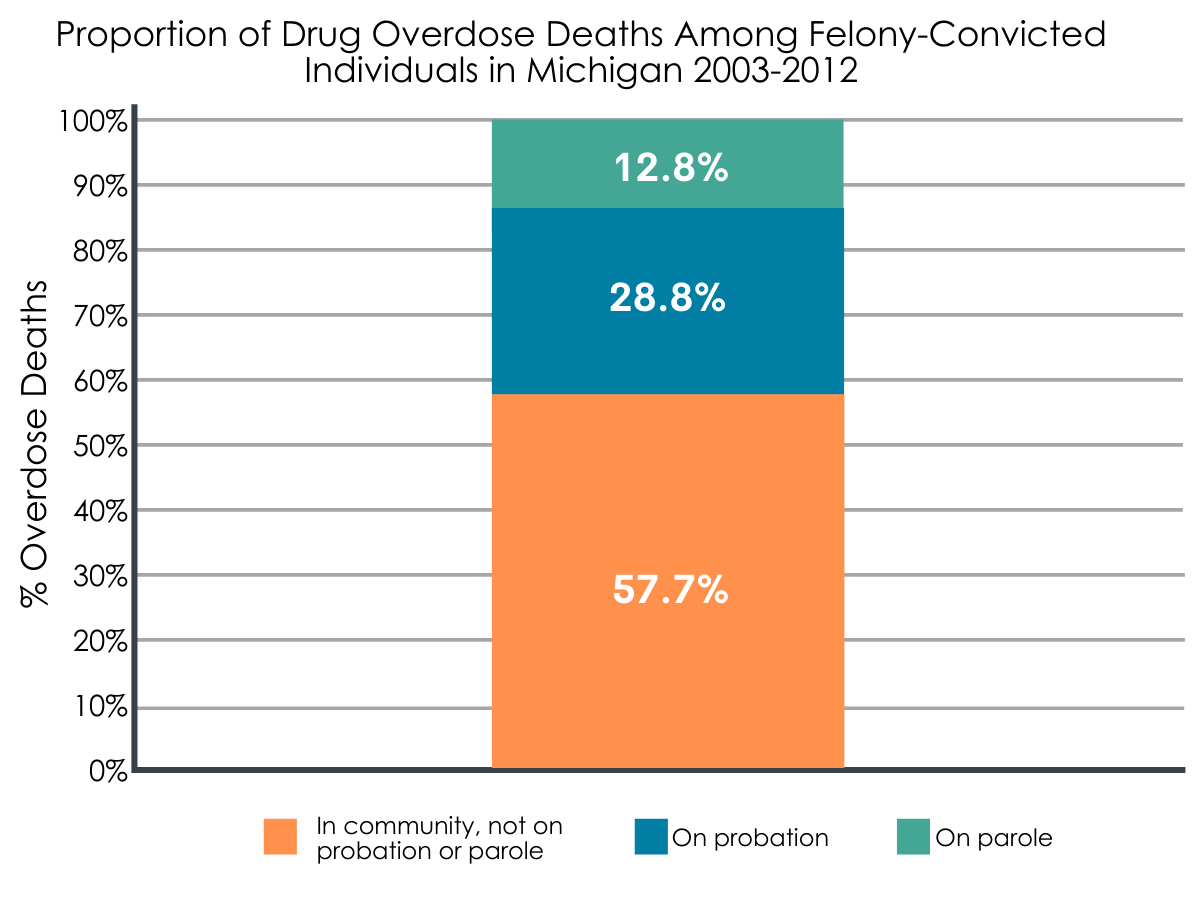High rates of overdose deaths after prison spotlight unmet need among felony-convicted individuals in Michigan
There is persistent concern about rates of opioid and other drug use harms, such as drug overdose, for individuals within the United States criminal justice system. This study is one of a few that highlight rates and risk factors for overdose death among felony-convicted individuals. By highlighting these risk factors, research can help identify needs and improve services for individuals following incarceration.
WHAT PROBLEM DOES THIS STUDY ADDRESS?
Drug use among felony-convicted and incarcerated individuals is a significant concern in the United States (US); 1 in 4 incarcerated individuals in the U.S. have engaged in illicit opioid use and use of other drugs is also common. Risk of overdose death is also significant in this population, especially during the weeks following release from jail or prison. At the same time, there is little information about which factors are associated with overdose risk in this population, or the supervisory circumstances under which overdose is most likely to occur (i.e., in the community vs. on parole vs. on probation).
In this study, researchers examined the incidence of drug overdose death among individuals charged with a felony in Michigan between 2003 and 2006, and rates of overdose and risk factors for these individuals through 2012. By highlighting these risk factors, research can help identify needs and improve services for individuals following incarceration.
HOW WAS THIS STUDY CONDUCTED?
This was a retrospective longitudinal cohort study in which the researchers used existing data from the Michigan Department of Corrections and data from the National Death Index (NDI) to look at trends in overdose death over time. The National Death Index is a centralized and national data archive that is commonly used for medical and epidemiological research, and for the purposes of documenting participant deaths, as well as timing and causes of death. For their analyses, the researchers focused on individuals 15 and older, who were charged as adults (excluding those under 18 who were charged as minors), and convicted of a felony in Michigan between 2003-2006, and sentenced to jail, prison, probation, or probation and jail. They then used data from the National Death Index database to examine rates of overdose deaths among these individuals until December 2012. The researchers followed participants, on average, for 7.8 years after their initial conviction.
The researchers were interested in using information obtained to examine rates of overdose deaths, and to examine factors related to drug overdose risk among individuals in this population. Specifically, they focused on pre-sentence substance use, as well as whether the participants’ felony convictions were for drug possession or delivery. The researchers also had access to demographic information, body mass index, substance use and mental health history, criminal histories, and information about whether individuals were in prison, on probation or parole, or in the community and not on probation or parole (i.e., “in the community”). Lastly, the researchers linked individual identifiers with corresponding National Death Index data, including cause of death (e.g., drug overdoses).
Participants included 140,266 individuals convicted of a felony in Michigan between 2003 and 2006, which excluded individuals in pre-trial detention, incarcerated for probation violations, serving life sentences, or serving special sentences (e.g., family or drug services). The majority of participants were male (82.9%), and slightly over half were White/Caucasian (58%). The mean age of participants was 31.8 years (SD = 11.1) with an age range spanning 15-94 years. A total of 11.5% of individuals reported daily, weekly, or occasional opioid use, with the majority of those using opioids also using other substances.
WHAT DID THIS STUDY FIND?
During the 7.8-year follow up period, the researchers found that 14.9% (1,131) of the 7,611 recorded deaths were overdose related. Just over half (56.1%) of the 1,131 overdose deaths involved at least one opioid, but the remainder did not. The majority of overdoses that involved opioids (60%) also involved other substances such as cocaine, benzodiazepines, or alcohol (figure 1).

Figure 1. 60% of overdoses that were opioid related also included another substance, such as cocaine (21%), benzodiazepines (14%), or alcohol (12%), among others (not reported).
Drug overdoses were most likely to occur within the community (57.7%), among individuals no longer on parole or probation, as opposed to while on probation (28.8%) or parole (12.8%). Overdoses rates increased significantly in the month following the end of probation, but rates of overdose were similar among individuals on parole vs. during the first month after parole ended.

Figure 2. Proportion of drug overdose deaths among felony-convicted individuals in Michigan from 2003-2012; in community and not on probation or parole, on probation, and on parole.
Individuals with a drug possession, but not delivery conviction, and with documented history of opioid use prior to conviction were more likely to die by overdose. Daily drug use prior to incarceration was associated with higher risk of post-incarceration overdose death with the exception of cannabis use, which was associated with reduced risk of overdose. Being in prison or on probation, but not parole, was associated with a lower risk of overdose compared to being in the community and not on probation or parole, which may relate to limited supply and the more controlled nature of the prison environment.
WHAT ARE THE IMPLICATIONS OF THE STUDY FINDINGS?
Over nearly 8 years of follow up following a felony conviction, 14.9% of all deaths recorded in this Michigan-based sample were overdose related, and just over half of these deaths involved opioids of various types and unknown quantities. Importantly, just under half (43.9%) were not opioid-related, and a significant proportion of overdoses that involved opioids also involved other substances. The use of administrative data provided substantial breadth but limited specifics around the exact nature of overdose deaths, such as whether they were accidental vs. intentional, type of substance used, quantities, and specific combinations; or which substance was the primary cause of death. It remains important to continue studying rates of overdose, by substance combination type, to increase our understanding of factors associated with overdose mortality, and to better target education, intervention, and policy.
Individuals were at higher risk of overdose during transitions periods, such as release from prison or completion of probation. The highest rate of overdose deaths occurred during parole, but the highest proportion of overdose deaths occurred among individuals in the community and no longer on probation or parole. Importantly, buprenorphine was not approved until 2002 and its use among prison and post-incarceration populations remains limited.
The findings from this study are consistent with prior research and support the need for enhanced support and intervention to reduce overdose risk among individuals leaving prison, on parole, transitioning from probation, and particularly among opioid users. Importantly, almost half of the overdose deaths did not involve opioids at all highlighting the need to address other alcohol/drug use in addition to opioids. Access and education around the effective use of ongoing treatment, including medications for opioid use disorder (for those with opioid use histories), and naloxone, could be especially helpful to these individuals, especially at times when they are losing countervailing supports, resources, and accountability. In addition, use of peer support and recovery coaches within criminal justice settings, or recovery community centers could provide essential support to individuals following incarceration.
- LIMITATIONS
-
- The study was conducted among individuals in one state and who were identified following a felony conviction between 2003 and 2006, and mortality data through 2012. Replication with a more current sample would be beneficial, as substance use and overdose trends vary annually.
- Although researchers found mental health treatment history was associated with increased overdose risk, the data did not include specific information about type of disorder, types and severity of opioid and other substance use disorders, treatment availability or receipt, or medication access and use.
- The researchers did not include information about the duration of parole, probation, or time spent unsupervised in the community and not on parole or probation. This could help contextualize the proportion of overdose deaths that were observed across levels of supervision.
- Use of administrative data provided substantial breadth but limited specifics around the exact nature of overdose deaths, such as whether they were accidental vs. intentional, type of substance used, quantities, and specific combinations; or which substance was the primary cause of death.
BOTTOM LINE
This study highlights the risk of overdose mortality among individuals previously convicted of a felony, and at different levels of supervision after release from prison (e.g., on parole vs. on probation vs. unsupervised in the community). These researchers found that risk for overdose was related to opioid and non-opioid substance use and was highest among unsupervised individuals in the community, followed by those on probation, then parole.
- For individuals and families seeking recovery: Risk of overdose was higher during transitions from prison or probation, when enhanced support from friends, family, peers, the community, recovery support services, and treatment providers could be especially useful. Proper education and access to medications like naloxone, which can help reverse an opioid overdose are especially important.
- For treatment professionals and treatment systems: Increased support and access to medications for opioid and addiction treatment, including naloxone to potentially reverse opioid overdose, could assist with lowering the odds of overdose death in this population. Access to medications for opioid use disorder during incarceration, has been shown to improve rates of recovery and reduce overdose death. The results of this study, highlighting elevated risk during key transition periods following incarceration, suggest that additional support could be beneficial to individuals during these periods. For example, peer support and recovery coaches within criminal justice settings, or on staff and available to individuals on probation or parole, could provide essential support to individuals following incarceration.
- For scientists: This study leveraged a state-wide database of felony-convicted Michigan residents to identify factors associated with overdose mortality over time. Just over half of mortality deaths involved opioids, of varying types and unknown doses, but also other drugs either by themselves or in combination with opioids. The results of this study underscore the scope of drug-related overdose death among individuals convicted of a felony in Michigan, factors associated with risk (e.g., white race, substance use and treatment history), and when risk is most elevated following release from prison. Given geographic differences and changes in drug overdose mortality rates over time, replication with more recent and geographically diverse data would be beneficial. It may also be beneficial to replicate these findings in a manner than allows for more granular assessment of opioid and other drug use, combinations of use, and quantities.
- For policy makers: Overdose mortality remains a critically important public health concern, and may be especially relevant among individuals who are, or who have been, criminally involved or previously incarcerated. Policy and practice that supports access to medications for opioid and other drug use disorders during incarceration and after have been shown to improve recovery and overdose rates. It could be useful to continue committing resources to better understand they types of substances, and combinations of substances, present risk for overdose, and to identify factors associated with risk. This information could be critically important for future policy and allocation of resources aimed at reducing risk for individuals following incarceration, and especially during the high-risk transition periods from prison, parole, probation, and to unsupervised community living.
CITATIONS
Binswanger, I. A., Nguyen, A. P., Morenoff, J. D., Xu, S., & Harding, D. J. (2020). The association of criminal justice supervision setting with overdose mortality: A longitudinal cohort study. Addiction, 115(12), 2329-2338. doi:10.1111/add.15077

